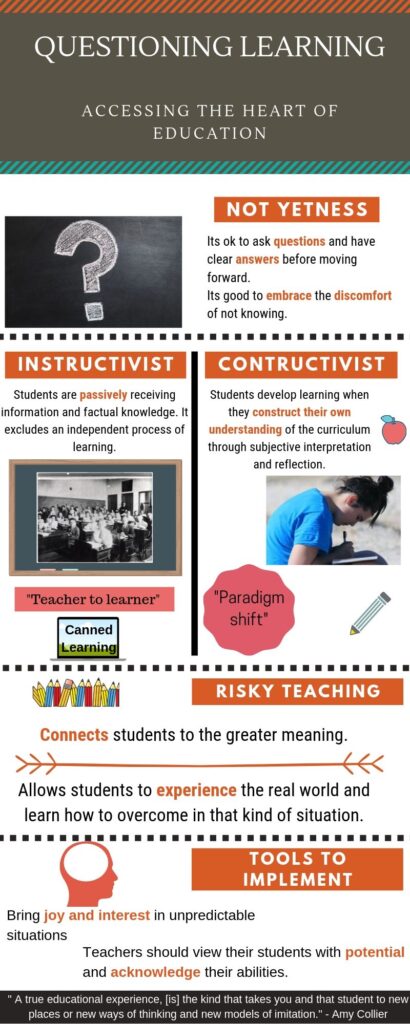For my multimedia reflection, I listened to the Chris Friends interview with Amy Collier, “Questioning Learning“. The podcast demonstrates the concept of critical pedagogy and the importance of a constructivist model of teaching to enhance the learning experience. A constructivist model prompts students to construct their own learning experiences through collaboration and exchange of ideas. The role of the teacher is to mediate learning and to encourage student engagement in the classroom. One of the main ideas that Amy discusses is “canned” or “online courses” and how that restricts students learning or as what Gert Biesta calls it, “the beautiful risk of education.” Teachers should strive for methods of thinking that create opportunities and intellectual growth. Taking risks in teaching brings passion and “fire” to the classroom and allows students to see greater opportunities in the curriculum. Teachers should be willing to try new things and make the most out of incalculable circumstances and experience with new methods of teaching. To facilitate learning, I believe that teachers should encourage student observation and allow students to come up with their own conclusions to shape educational learning.

One of the key moments that stood out to me was the example of the “basketball court”, in which a math teacher demonstrates a video of himself standing on a basketball court aiming to shoot the ball. He launches the basketball and then stops the video with the ball halfway through its arc. Such a demonstration immediately makes someone ask “did he make it?” The video creates a sense of uncertainty and brings out an inherent curiosity. Instead of delivering a lesson based on content and memorization, he is encouraging a learning outcome that says, “This is going to COMPEL my students to learn.” Education should not focus on what students should learn, but that they learn something for particular purposes and be able to ask questions such as “What’s the real meaning behind this sociological phenomenon?” or “how can this be applied to my educational pedagogy?”

I believe that following a rigid curriculum de-risks the future of students and where they may end up in the real world. Within a classroom, taking risks should become something that we learn to adapt to. It allows us to operate in unpredictable situations. By using methods that appeal to student learning such as a simple basketball, teachers are bringing joy and excitement and allowing students to engage in difficult subjects, such as math.

Listening to the podcast made me reflect on my high school days and all those projects and assignments I spend hours doing, only for it to be graded and handed back to me, with zero feedback and little knowledge about how this particular assignment will be useful to me in the future. Therefore, it is essential to incorporate critical pedagogy into the curriculum because it gets students out of their comfort zone and allows them to think about topics in an exciting and innovative way. Rather than following the traditional way, it is crucial to understand that student thinking has changed and the way students understand and comprehend information is different for everyone.
For my artifact, I decided to create Canva because I wanted to experiment with technological websites and take a “risk” as the podcast suggests. Although I originally wanted to do a twitter essay, I believe that deciding on the infographic was very useful because it gave me the freedom to express my creativity. However, the website is not user-friendly, and I had constant moments of frustration because I couldn’t change the size of the textbox or insert a caption. After a few tries, I was able to become more familiar with the website and capture a visual image of the podcast. Having such creative sites allows students to incorporate their creative and artistic skills, which can be very useful for teachers to use in classroom assignments.

